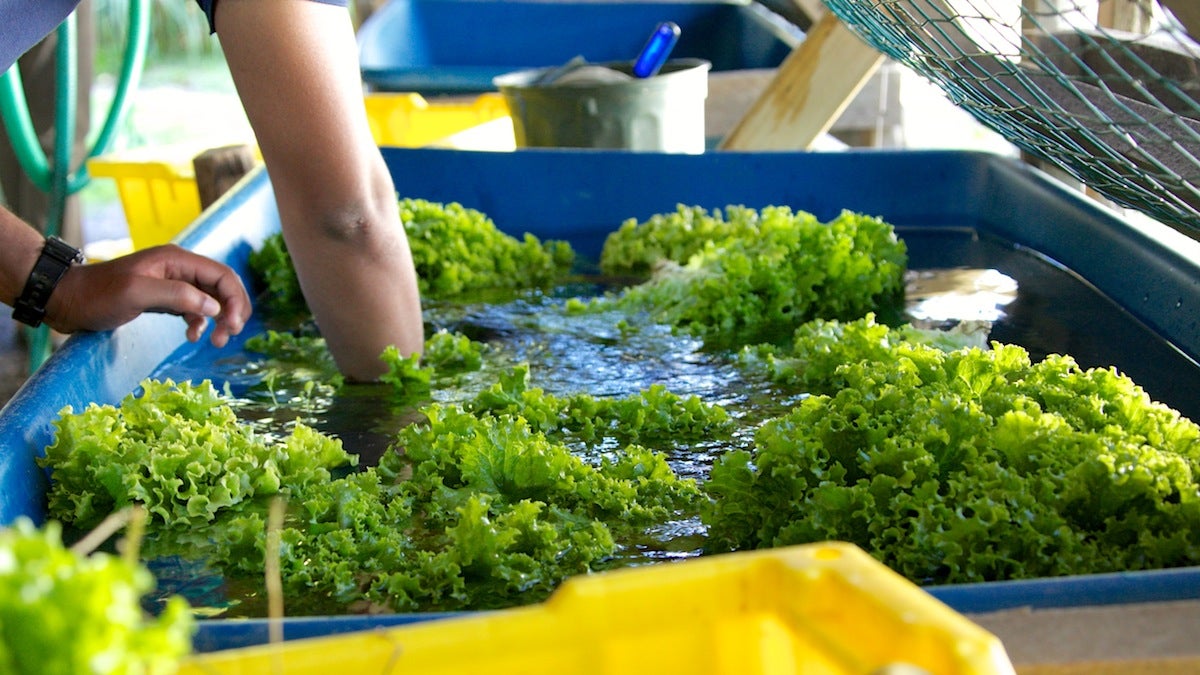Saul cafeteria now serving up school harvest
Listen
There are many opportunities for student involvement, ranging from hands-on work in the fields to helping with community outreach and newsletter-writing to doing applied research, budgeting and planning. (Nathaniel Hamilton/for NewsWorks)
The lunch menu at W.B. Saul Agricultural High School now features some very locally-sourced food.
Earlier this month, lettuce and tomatoes grown on the school’s farm in Roxborough became a permanent part of the lineup offered each school day to nearly 600 students.
The fresh produce, harvested by Saul students, is used for salads, folded into wraps and stacked into sandwiches.
Sharon Handzus, the school’s food service manager, said the move was a no-brainer.
“What’s more rewarding for the children than to have them eating what they’re farming,” said Handzus.
A full circle
In 2009, Saul helped launch “Henry Got Crops,” the Philadelphia School District’s only high-school based community supported agriculture program.
On a 2.5-acre farm along Henry Avenue, students are exposed to sustainable urban farming by getting their hands dirty.
The program — the result of a partnership between Saul, Weavers Way Co-op, Weavers Way Community Programs and the city’s Department of Parks and Recreation, which owns the land — then offers up chemical-free vegetables to the larger community, who for a yearly fee, can receive weekly portions of the farm’s yield.
Students have had opportunities to enjoy the fruits of their labor, but never on this scale or this regularly.
“It just completes the circle of experience and knowledge here at the farm,” said farm manager Nina Berryman of Saul’s “Farm to Cafeteria” initiative.
“Students can not only understand the science and the work that goes into growing vegetables, but then they can also benefit from the nutritional value and experience the taste and the different culinary applications it can be used for in their lunches.”
The lunchtime crowd
On a recent Friday afternoon, a stream of Saul students funnels into the cafeteria’s cramped lunch line.
A number of students exit with pizza and fries, but the school’s new deli counter, where the farm’s veggies sit, is doing brisk business too.
Sophomore Zain Wilson emerges from the line and grabs a seat at a long, fold-out table near the front entrance of the cafeteria, which doubles as the school’s auditorium. He said he usually gets hot food, but has been eating more salads lately.
“I know it’s coming from across the street from the farm and I know they have fresh soil and they wash it off good,” said Wilson.
Classmate Dontae DeShields said the greens taste better than what he’s had elsewhere.
“What you get from the market, it doesn’t taste as good as you want it to, but the ones here, it actually has a taste so you’ll actually like it and enjoy it,” said DeShields.
On the farm
Any Saul teacher can use the farm as a learning tool and most students spend some time there at some point. Others, like senior Terrell Fontaine, are out on the farm five days a week.
For Fontaine, the school’s new program is a point of pride.
“I know what they’re eating I actually harvested. It’s a good feeling,” said Fontaine before freeing a head of lettuce for an upcoming delivery to the cafeteria.
The hope is that those good vibes give students a deeper connection to the work they do on the farm. Longtime Saul teacher Jessica McAtamney, who helped get “Henry Got Crops” off the ground, said she also expects the initiative to motivate students.
“It’s not just work, it’s not just for a grade, it’s for their mouths,” said McAtamney.
Going forward
Before temperatures cool off, deliveries will be made to the cafeteria once or twice a week. Once winter hits, produce will come in every other week.
The farm, like another other vendor, now has an agreement with the district’s Division of Food Services. The CSA is expected to provide between $3,500 and $7,500 worth of produce during the school year, although there is no minimum purchase.
Berryman, the farm manager, said that $5,000 would, for example, cover 3,125 heads of lettuce.
Other produce, like fruit from the farm’s newly planted orchard, will likely appear in the cafeteria when the weather warms up.
Deirdre Darragh, a district spokesperson, said the district has not yet committed to continuing the program beyond this school year, but that there’s interest in keeping it going and expanding.
It’s safe to say the “Henry Got Crops” community hopes that happens.
“It seems silly to have a high school right next to a farm and not have them get any benefit from it, especially when they are the ones doing the weeding and grunt work,” said Georgia Kirkpatrick, a Mt. Airy resident and CSA member. “I think just knowing that their efforts are being rewarded that way is really nice to know.”
WHYY is your source for fact-based, in-depth journalism and information. As a nonprofit organization, we rely on financial support from readers like you. Please give today.





